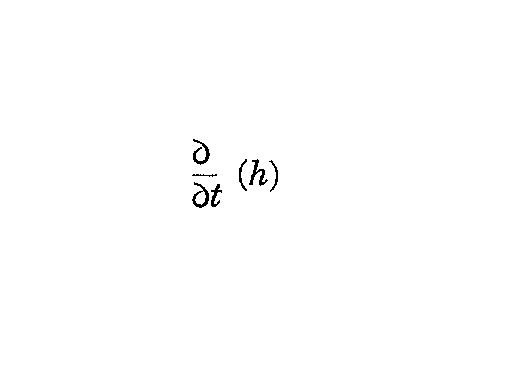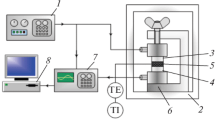Abstract
An analytical assessment is made of an apparatus designed for the measurement of the complex shear modulus of viscoelastic materials. It is shown that simple measurements of amplitude ratio and phase angle are sufficient to determine the complex modulus at any point over a wide range of frequency and dynamic strain. Data obtained for butyl rubber and some experimental elastomers are presented.
Similar content being viewed by others
Abbreviations
- A :
-
specimen area
- b :
-
specimen thickness
- c :
-
velocity of shear waves in an elastic\(material = \sqrt {G/_\rho } \)
- f :
-
the frequency of vibration
- G :
-
elastic shear modulus
- G * :
-
complex shear modulus=G′+iG″=G 0 exp (iθ)
- G′:
-
storage modulus in shear=G 0 cos θ
- G″:
-
loss modulus in shear=G 0 sin θ
- G 0 :
-
magnitude of the complex shear modulus
- θ:
-
loss angle in shear=arc tan (G″/G′)
- i :
-
\(\sqrt { - 1} \)
- Q :
-
displacement amplitude of lower block
- \(\bar Q\) :
-
displacement amplitude of upper block or free mass
- R :
-
ratio,\(\bar Q/Q\)
- u :
-
displacement in thex direction
- W :
-
weight of the free mass, the center of gravity of which is at the top of the specimen
- x, y :
-
rectangular coordinate axes
- ω:
-
circular frequency=2πf
- ϕ:
-
phase angle between the lower and upper blocks
- τ:
-
shear stress
- ϱ:
-
mass density of the specimen material
- \(\dot h\) :
-

- H :
-
\(\left( {\omega ^2 Mb} \right)/A\)
- g :
-
acceleration of gravity=386 in./sec2
- k :
-
\(\frac{\omega }{c} = \frac{\omega }{{\sqrt {G/\rho } }}\)
- k * :
-
\(\frac{\omega }{{\sqrt {G^* /\rho } }}\)
References
Snowdon, J. C., “Representation of the Mechanical Damping Possessed by Rubberlike Materials and Structures,”Jnl. ASA,35 (6),821–829 (June1963).
Gross, B., Mathematical Structure of the Theories of Viscoelasticity, Hermann and Company, Paris (1953).
Read, W. T., “Effect of Stress-Free Edges in Plane Shear of a Flat Body,”Jnl. Appl. Mech.,17,349–352 (December1960).
Alfrey, T., Jr., “Non-Homogeneous Stresses in Viscoelastic Media,”Quart. Appl. Math.,2,113–119 (July1944).
Lee, E. H., “Stress Analysis in Viscoelastic Bodies,”,13,183–190 (July1955).
Read, W. T., “Stress Analysis for Compressible Viscoelastic Materials,”Jnl. Appl. Phys.,21,671–674 (July1950).
Berry, D. S., “Stress Propagation in Viscoelastic Bodies,”Jnl. Mech. Phys. Solids,6,177–185 (1958).
Maxwell, B., “An Apparatus for Measuring the Response of Polymeric Materials to an Oscillating Strain,”ASTM Bltn. No. 215, 76, (July1956).
Author information
Authors and Affiliations
Rights and permissions
About this article
Cite this article
Adkins, R.L. Design considerations and analysis of a complex-modulus apparatus. Experimental Mechanics 6, 362–367 (1966). https://doi.org/10.1007/BF02327213
Issue Date:
DOI: https://doi.org/10.1007/BF02327213





